|
|
|
|
|
Intel "Pentium D" and "840 Extreme Edition" Dual-Core CPUs |
|
Join the community - in the OCAU Forums!
|
Benchmarking Software and Results
BENCHMARKING SOFTWARE:
Contemporary standard benchmarks like “Business Winstone”, “WorldBench”, or “SYSMark” are not sufficiently reflecting the performance potential of dual core processors. Most of these benchmarks are running single-threaded in a single task environment. Only a few of them are running applications multithreaded like PCMark 2004 or trying to simulate some low-level multitasking like “WorldBench” or “Business Winstone”. These benchmarks are therefore insufficiently discerning between single and dual core processors. We therefore added 4 “hand-made” multitasking tests to the usual assortment of standard benchmarks. Each of these tests is simulating different multitasking scenarios close to real world desktop usage. Instead of inventing our own tests we utilized the multitasking scenarios that the well-known IT site AnandTech has put together and is using for their dual processor testing here. The content of our multitasking scenarios is almost identical with their set-up.

BENCHMARKING RESULTS:
For the interpretation of the following benchmarks it is important to strictly differentiate between 2 different types of applications and 2 different types of computing environments. These are: single threaded and multithreaded, single tasking and multitasking. Just looking at the results without considering how the benchmark is designed and how the scores are obtained would be misleading. There is no performance gain to expect from a dual core processor when running a single threaded application. The reader should also not forget that we are comparing products of vastly different pricing: for the price of one 840XE or X2 4800+ it is possible to buy almost four Pentium D 820 CPUs.
The Sandra CPU tests are running multithreaded. Dual core but also HT capable CPUs have therefore an advantage in this benchmark. In particular the multimedia benchmark benefits from HT and dual core processing and the 840XE running with 4 “virtual” cores takes the lead in this benchmark.
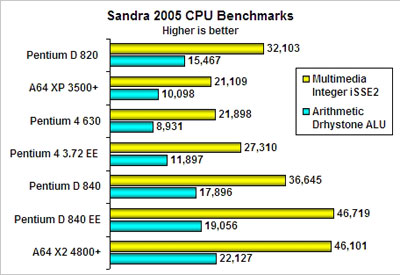
Sandra shows that a Pentium D system provides roughly the same memory bandwidth as a single core P4 system. That is no surprise as Intel’s 500, 600, and 800 series CPU are all running with the same FSB frequency of 800 MHz. In comparison with the preceding 915/925 chipset we found that Intel has obviously managed to squeeze around 300 MB/sec more bandwidth out of the 955X memory controller. The A64 architecture with an on-die memory controller provides for higher bandwidth and lower latencies than a P4 system with an off-die memory controller (aka “Northbridge”). Only the 3.73 GHz XE manages to outrun the A64, because of the high default FSB frequency of 1066 MHz.
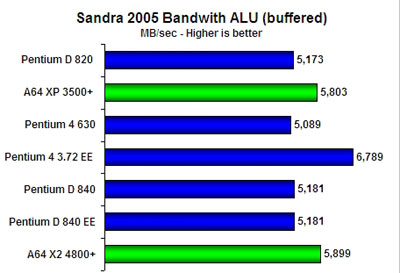
“Business Winstone 2004” is benchmarking system performance with workstation usage in mind. It is mainly based on business applications like MS Access, MS Excel, MS Frontpage, MS Outlook, MS Power Point, MS Project, MS Word, Norton AntiVirus and WinZip. It runs these applications through a series of scripted activities and uses the time a PC takes to complete those activities to produce its performance scores. As this benchmark doesn't make use of the P4 HT capability it has always been a stronghold of AMD processors. The MS office applications used in BW 2004 are running single threaded and it is no surprise that a dual core processor does not offer any advantage in this benchmark. A 3.2 GHz 840 doesn’t perform any better than a single core P4 clocked at the same frequency level.
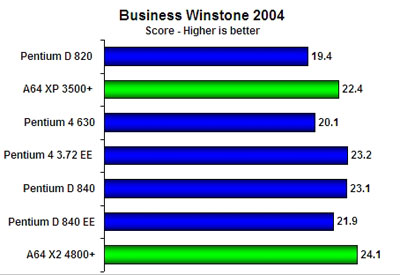
BW 2004 includes a low-level multitasking test as well. We quote from the manual: “This test uses the same applications as the Business Winstone test, but runs some of them in the background. The test has three segments: in the first, files copy in the background while the script runs Microsoft Outlook and Internet Explorer in the foreground. The script waits for both foreground and background tasks to complete before starting the second segment. In that segment, Excel and Word operations run in the foreground while WinZip archives in the background. The script waits for both foreground and background tasks to complete before starting the third segment. In that segment, Norton AntiVirus runs a virus check in the background while Microsoft Excel, Microsoft Project, Microsoft Access, Microsoft PowerPoint, Microsoft FrontPage, and WinZip operations run in the foreground." The BW multitasking score shows the benefit of a dual core processing. All 3 Pentium D are now ahead of the single core P4, and the 3.2 GHz 840 is outrunning the much higher clocked 3.73 GHz XE.
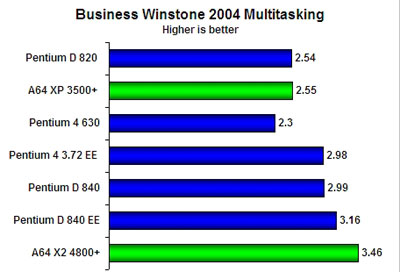
“PCMark 2004” is an application-based benchmark. It uses portions of real applications instead of including very large applications or using specifically created code. PCMark is designed to stress the PC in the same manner as typical home usage does. The “System Test Suite” is a collection of tests that are run to generate an overall “PCMark” score. There are thirteen tests in all in this suite. Three pairs of tests are run multithreaded – each test in the pair is run in its own thread. The remaining seven tests are run single threaded.
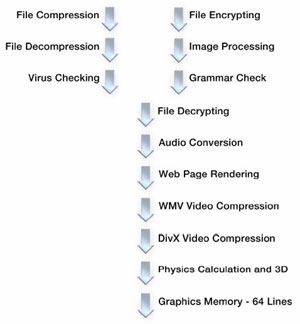
PCMark has been a favorite tool for benchmarking HT enabled P4s in the past, because of its multithreaded test runs. For the same reason it’s also an appropriate benchmark for dual core CPUs. The results with PCMark were among the most interesting in our tests.
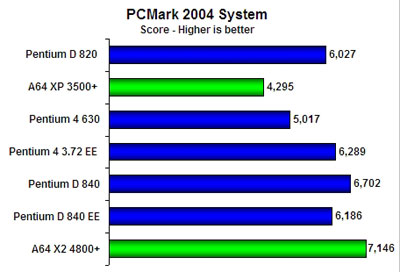
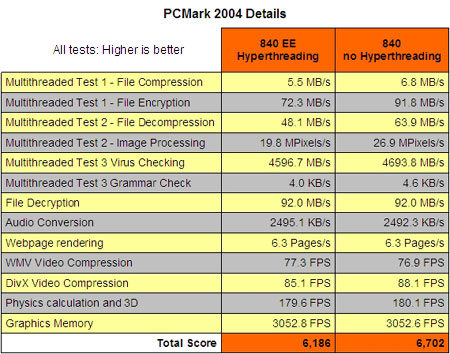
First of all we see that a single core CPU without HT capability, like the XP 3500+, performs badly in this benchmark. Then we can see that the dual core 2.8 GHz 820 performs almost as good as the single core 3.73 GHz XE. And the dual core 3.2 GHz 840 is by far outrunning the 3.73 GHz XE. But we see also for the first time that an AMD processor is taking the lead in this benchmark. The 840XE is not only performing much worse than the X2 4800+, it’s even falling behind the 840. That is very surprising because the 840XE with 4 virtual CPU should perform in this multithreaded benchmark on top of the competition. The “System Suite” subtest results revealed something astonishing: in all 3 multithreaded subtests the 840XE with HT performs worse than the 840 without HT. We initially speculated that PCMark doesn’t recognize 4 processors and would allocate the workload to only 2 cores. However, Windows Task Manager showed that all 4 virtual 840XE cores were working, although in a rather bizarre utilization pattern. Obviously PCMark cannot balance the workload between 4 processors in an optimal way. On top of this, performance could suffer by increased overheads caused by the allocation process. Whatever the reason is, PCMark shows that software must be specifically designed to run with 4 cores, otherwise there is no advantage, or even a performance penalty.
|
|
Advertisement:
All original content copyright James Rolfe.
All rights reserved. No reproduction allowed without written permission.
Interested in advertising on OCAU? Contact us for info.
|

|


